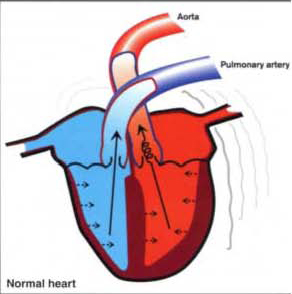Oleh : NINDYA KUSUMA, DRH
 |
Sumber : BSAVA Manual of Canine and
Feline Cardiorespiratory Medicine 2ed
|
Jantung merupakan organ vital yang terdiri atas
atrium kanan dan kiri, ventrikel kanan dan kiri. Jantung dalam tubuh berfungsi memompa
darah untuk mengirimkan oksigen dan nutrisi ke jaringan-jaringan tubuh dan memenuhi
kebutuhan metabolisme tubuh. Seiring bertambahnya usia pada anjing dan kucing
maka beresiko juga menderita penyakit jantung. Rata-rata peningkatan risiko
penyakit jantung pada anjing usia tua.
Penyakit jantung juga bisa disebabkan karena
obesitas. Obesitas adalah akumulasi lemak berlebihan di dalam tubuh. Penyebab
utama obesitas adalah asupan kalori yang berlebihan dan exercise yang kurang. Jika asupan kalori
melebihi energi yang dibakar oleh tubuh maka kelebihannya akan disimpan. Lemak
yang beredar di dalam peredaran darah maka akan membuat kerja jantung semakin
berat untuk memompa. Selain itu, Anjing dan kucing yang memiliki kelebihan
berat badan cenderung tekanan darahnya tinggi (hipertensi) sehingga jantung
memiliki beban kerja meningkat karena harus memompa darah untuk pertambahan
jaringan. Hal ini akan membuat kerusakan pada jantung atau congestive heart failure.
Terapi penyakit jantung dengan mengatur kandungan makanan yang akan dimakan oleh hewan kesayangan kita. Menurut jurnal Veterinary World, Vol.2(12):482-485 Anjing yang menderita penyakit jantung umumnya kehilangan massa otot (terjadi di sekitar 50% dari pasien jantung dengan kongestif gagal jantung). Penyakit CHF, asam amino dari otot sumber utama energi yang mengakibatkan hilangnya massa tubuh.
Terapi penyakit jantung dengan mengatur kandungan makanan yang akan dimakan oleh hewan kesayangan kita. Menurut jurnal Veterinary World, Vol.2(12):482-485 Anjing yang menderita penyakit jantung umumnya kehilangan massa otot (terjadi di sekitar 50% dari pasien jantung dengan kongestif gagal jantung). Penyakit CHF, asam amino dari otot sumber utama energi yang mengakibatkan hilangnya massa tubuh.
Nutrisi untuk Anjing yang menderita CHF yaitu beralih ke makanan dengan asupan gizi yang memenuhi. Diet buatan sendiri dengan rendah sodium. Suplementasi asam lemak Omega-3 menurunkan produksi sitokin. Dan nutrisi dari minyak ikan dengan kandungan omega-3 asam lemak.
Diet klorida juga diperlukan, tetapi penelitian menunjukkan bahwa klorida mungkin penting dalam pengelolaan optimal CHF. Diet klorida bermanfaat untuk mengurangi renin plasma.
Berbagai kekurangan nutrisi telah diketahui menyebabkan berbagai jenis penyakit jantung. Ini termasuk kekurangan tiamin , magnesium , vitamin E , selenium , dan taurin. Meskipun penyebab kekurangan gizi atau gizi tidak seimbang umumnya jarang terjadi. Tetapi masih mungkin menyebabkan beberapa penyakit jantung.
Taurin: Tidak seperti kucing, anjing dianggap mampu mensintesis jumlah yang cukup taurin endogen dan taurin tidak dianggap diperlukan dalam diet anjing. keturunan tertentu anjing dengan DCM (misalnya, Cocker Spaniel, Golden Retriever, Labrador Retriever, Saint Bernard, Inggris Setter dan Golden Retriever) melakukan memiliki konsentrasi taurin rendah.
Arginine: Berdasarkan temuan endotel. Disfungsi pada pasien dengan CHF, suplemen L-arginin menunjukkan mengurangi rate jantung dan resistensi vaskular sistemik, dengan tidak ada negatif efek pada kontraktilitas jantung.
Lemak: Lemak merupakan sumber kalori dan asam lemak esensial dan meningkatkan palatabilitas diet. Anjing dengan gagal jantung memiliki konsentrasi plasma rendah dari asam eicosapentaenoic. Oleh karena itu, kandungan asam lemak bermanfaat bahkan sebelum menderita CHF.
Diet klorida juga diperlukan, tetapi penelitian menunjukkan bahwa klorida mungkin penting dalam pengelolaan optimal CHF. Diet klorida bermanfaat untuk mengurangi renin plasma.
Berbagai kekurangan nutrisi telah diketahui menyebabkan berbagai jenis penyakit jantung. Ini termasuk kekurangan tiamin , magnesium , vitamin E , selenium , dan taurin. Meskipun penyebab kekurangan gizi atau gizi tidak seimbang umumnya jarang terjadi. Tetapi masih mungkin menyebabkan beberapa penyakit jantung.
Taurin: Tidak seperti kucing, anjing dianggap mampu mensintesis jumlah yang cukup taurin endogen dan taurin tidak dianggap diperlukan dalam diet anjing. keturunan tertentu anjing dengan DCM (misalnya, Cocker Spaniel, Golden Retriever, Labrador Retriever, Saint Bernard, Inggris Setter dan Golden Retriever) melakukan memiliki konsentrasi taurin rendah.
Arginine: Berdasarkan temuan endotel. Disfungsi pada pasien dengan CHF, suplemen L-arginin menunjukkan mengurangi rate jantung dan resistensi vaskular sistemik, dengan tidak ada negatif efek pada kontraktilitas jantung.
Lemak: Lemak merupakan sumber kalori dan asam lemak esensial dan meningkatkan palatabilitas diet. Anjing dengan gagal jantung memiliki konsentrasi plasma rendah dari asam eicosapentaenoic. Oleh karena itu, kandungan asam lemak bermanfaat bahkan sebelum menderita CHF.
Magnesium: Magnesium memainkan peran penting dalam
fungsi kardiovaskular normal. Hal ini juga jelas bahwa
perubahan dalam magnesium homeostasis pada anjing yang
umum
dan dapat memiliki efek merusak
dalam berbagai kondisi kardiovaskular
seperti hipertensi, penyakit gagal
jantung kongestif, dan aritmia jantung.
Sumber
:
Canine And Feline
Nutrition 3rd Ed. 2001. Elsevier.
Canine Nutrition.
William D. Cusick. 1997.
Veterinary World, Vol.2, No.12, Desember 2009.






